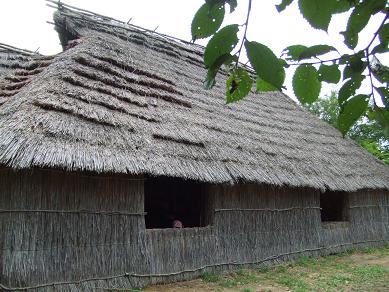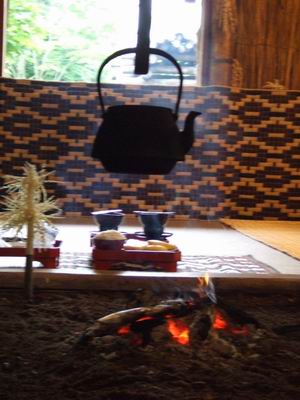The Ainu - some cultural aspects
excerpts from the websites indicated below, edited by W. Dallmann and K.Uzawa
The Ainu are an indigenous people, originally residing in Hokkaido and the north of Honshu in northern Japan, the Kuril Islands, much of Sakhalin, and the southernmost third of the Kamchatkan peninsula. The name Ainu is derived from the word aynu, which means "human" (particularly as opposed to kamuy, divine beings) in the Hokkaido dialects of the Ainu language. Today, many Ainu identify themselves, with more affection, as Utari (“comrade” in the Ainu language). In official documents both names are used. Today, the Ainu are in many ways assimilated into mainstream Japanese society.
Traditional forms of subsistence
Traditional occupations were hunting of land and marine mammals, fishing (freshwater and sea) and gathering, as well as some minor agriculture. Deer was hunted regularly, bear for special occasions. Their traditional cuisine consists of wild game, as well as fish, fowl, millet, vegetables, herbs, and roots. Ainu cuisine is not commonly eaten outside Ainu communities; there are only a few Ainu restaurants in Japan, all located in Tokyo and Hokkaido. Even though many Ainu are assimilated into the mainstream Japanese culture, they retain a bit of their traditional food culture in their daily cuisine, especially in Hokkaido.
Traditional clothing and ornamentation
Their traditional dress is a robe spun from the bark of the elm tree. It has long sleeves, reaches nearly to the feet, is folded round the body, and is tied with a girdle of the same material. Women also wear an undergarment of Japanese cloth. In winter the skins of animals were worn, with leggings of deerskin and boots made from salmon skin.
Both sexes are fond of earrings, and women highly prized bead necklaces called tamasay.
Never shaving after a certain age, the men had full beards and moustaches. The women tattooed several body parts starting at the onset of puberty.
Traditional housing
Their traditional habitations were reed-thatched huts, as large as 35 m2, without partitions and having a fireplace in the center. There was no chimney, but a hole at the angle of the roof; there was one window on the eastern side, and one or two doors. The house of the village head was used as a public meeting place.
 |
Chise (the house, in the Ainu language): The Ainu house is made out of kaya, which are thatch plants. The Ainu lived in such dwellings until about 100 years ago. These houses are still maintained for traditional ceremonies and spiritual purposes; the structure of the Ainu house follows certain rules relating to the Ainu spiritual world. There is usually a window in the east side to welcome kamuy (a spirit) from the outside to the inside of the house, which is a common belief in the Ainu culture. Inaw – sacred, peeled sticks symbolizing birds – accompany a man’s prayers to the spirit world. Photo: Kanako Uzawa
|
 |
Apefuchi kamuy (fire kamuy): This is everything that is around human beings, whether it holds a spirit or not, for instance, trees and cups, etc. It could be anything that human beings use in their daily life. Kamuy delivers wishes of a human being, and appreciation is rendered to each kamuy. Apefuchi kamuy is physically and mentally closer to human beings compared to other kamuy. Photo: Kanako Uzawa. |
Language
No attempt to show a relationship with Ainu to any other language has gained wide acceptance, and Ainu is currently considered to be a language isolate.
Ainu is a moribund language, and has been endangered for at least the past few decades. Most of the ethnic Ainu in Japan speak only Japanese. In the town of Nibutani (part of Biratori, Hokkaido) where some of the remaining native speakers live, there were appoximately 100 speakers, out of which only 15 used the language every day in the late 1980s. Today, fewer than 10 Ainu speakers are left there. The total number of speakers today is not known. In all of Hokkaido, it is estimated that there are perhaps 1,000 native speakers, almost all older than 30.
However, use of the language is on the rise. There is currently an active movement to revitalize the language. In predominantly Ainu communities, there are private language schools for those who like to learn the Ainu language. The Ainu language can also be studied on an optional basis at university. This has led to an increasing number of second-language learners, especially in Hokkaido. Among Ainu speakers (broadly defined), second-language learners presently outnumber native ones.
Religion
The Ainu are traditionally animists, believing that everything in nature has a kamuy (spirit) on the inside. There is a hierarchy of the kamuy. The most important is grandmother earth (fire), then kamuy of the mountain (animals), then kamuy of the sea (sea animals), and lastly everything else. There are no priests by profession. The village chief performs whatever religious ceremonies are necessary. The Ainu people believe their spirits are immortal, and that their spirits will be rewarded hereafter by ascending to kamuy mosir (Land of the Spirits).
Some Ainu in the north are members of the Russian Orthodox Church.
Further information on the Internet:
http://www.ainu-museum.or.jp/english/english.html
http://en.wikipedia.org/wiki/Ainu_people
http://www.workingdogweb.com/Ainu.htm http://www.voicenet.co.jp/~jeanphi/ngo/indigenous/ainu/ainu.htm

